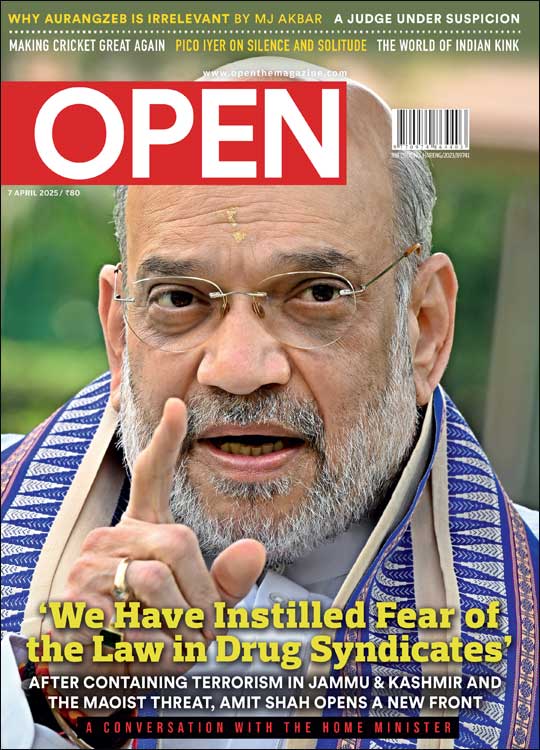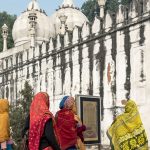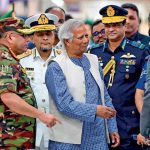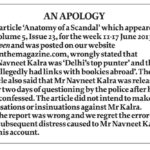The truth about heat wave deaths
Scorched earth, death by sun and more horror stories about the heat wave. Our correspondent travels through the worst hit areas in Andhra Pradesh and finds out that the reported death toll is an exaggeration
 Omkar Khandekar
Omkar Khandekar
 Omkar Khandekar
Omkar Khandekar
 |
04 Jun, 2015
|
04 Jun, 2015
/wp-content/uploads/2016/01/18752.heat1_.jpg)
On the evening of 23 May, as she downed the shutters of her tiffin shop in Kothapatnam village in Andhra Pradesh, Padmavati Sanagapalli decided to board a bus to town early the next day. It was 14 days since her brother had passed away and his family was holding a religious ceremony at their house in Ongole, around 20 km away from her village in Prakasam district. The temperature of the coastal town had soared in the past few days and delaying her departure would mean facing the blaze both ways. When she returned, she found her 56-year-old husband Sanagapalli Srinivas Rao fast asleep inside the shop. Without a second glance, she started manning the counter. The siesta didn’t hurt business; the crowd had been thin in the afternoons with most people staying indoors. “An hour later, I checked on him again but he still lay there, unmoving. I panicked and called for the doctor,” she says a week later, sitting in a local community hall along with her daughter and a few relatives. It is an austere setting: the duo sit on two mats on a granite floor as their relatives mill about a few feet away from the deceased’s framed photograph propped on a plastic chair.
Word of heat wave casualties has become increasingly shrill among locals. In the absence of a plausible explanation of why a ‘perfectly healthy man’ would suddenly die, the family decides to believe that the calamity has struck their household as well. Informed of it, the local tehsildar has sent his daily count of heat-wave deaths to the district collector: two in a population of 50,000.
The heat wave, which started off as a ‘news brief’ shoved to the margins of newspapers, now has top billing in the Indian and international media. Headlines flash that the southern states of Andhra Pradesh and Telengana are bitten by a heat wave. The all-India death toll has reportedly crossed 2,000, making it the fifth most lethal heat wave in the world.
On 26 May, as the number of reported deaths continued to mount, the Andhra Pradesh government declared ex-gratia compensation under the Chief Minister Relief Fund (CMRF) amounting to Rs 1 lakh for each victim. To weed out false claims, each of these deaths was to be investigated by a three-member committee consisting of a medical officer, tehsildar and police officer. “In order to accelerate the process and keeping in mind the sentiments of the people, the government ruled out post-mortems,” says Sujatha Sharma, the collector of Prakasam.
When Dr D Rosaiah, in charge of the local primary health unit, visited the late Sanagapalli Srinivas’ family, they told him exactly what they had said to me. “But we made a few additional inquiries with the neighbours and found out that the deceased was suffering from tuberculosis,” says the doctor, “The nurses at my centre confirmed that he used to visit the [primary health unit] to procure medicines. But over the last few months, he had stopped taking them.” It wasn’t the heat wave that killed Sanagapalli, Dr Rosaiah had concluded, but multi- drug resistant tuberculosis.
Among the 13 cases that the doctor later examined from the village, he found that only four deaths were caused by the heat wave. The rest died of heart diseases, HIV, and, in a few cases, natural causes. “Since there is no post-mortem conducted on the victims and the findings are based only on inquiries, one can never be hundred per cent certain about the cause of death,” he says, “But what I have generally observed is that people are aware of the compensation they are entitled to. Often, they end up reporting a natural death as one caused by the heat wave.”
I ask a senior IAS officer about this alleged tendency of people to capitalise on the compensation being offered. While I get a confirmation on the trend in general, the officer refuses to make such a comment on-record, fearing he would be labelled as an ‘insensitive’ administrator. Till last week, by the time the mercury had slowly started to recede in the state; Kothapatnam had reported 14 cases of heat-wave related fatalities. After investigations, the number of families eligible for compensation stood at just five.
A heat wave, as defined by India’s National Disaster Management Authority, is a condition declared when the maximum temperature at a weather station crosses 40° Celsius for plains and 30° for hill stations. Worst affected by a heat wave are usually the poor. Symptoms of heat-induced illness range from fatigue and nausea to headaches and dizziness. But it only becomes fatal when those in a ‘red zone’ (as marked on an isotherm map) are hit by a sunstroke, mainly caused by prolonged exposure to the sun and inadequate intake of fluids.
For someone tracking the numbers, however, the emerging data is difficult to grapple with. The number of dead varies depending on which news source one refers to. For example, on 28 May, the Telugu daily Eenadu reported that nearly 2,600 people had lost their lives in the past one week in the two states. On the same day, the news channel NDTV pegged the figure at 1,700, whereas The Times of India claimed that 900 had died in the region. By broad consensus, the cities of Prakasam, Guntur and Visakhapatnam are said to be the worst hit. These three coastal cities have reported an aggregate toll of 751 deaths, and the entire state, a total of 1,709.
One of the main agencies supplying figures to the media is the disaster management unit of the respective states. However, given the conflicting numbers, journalists and authorities say that it is probably a result of ‘an initiative taken by the regional media’. A correspondent of Eenadu in Telangana admits as much. “Unlike the mainstream media, regional dailies have a presence at the grassroots and report deaths as they emerge. We get our data from the mandal level (an administrative block which several villages under it). Many of those in the mainstream media also take this data from us and report it,” he says. There is, however, one flaw in this grassroots reportage: instead of delving into the cause of deaths, all fatalities are clumped as ‘heat wave related’. In the last week of May, in order to generate awareness of the deaths, the authorities started holding special programmes. Srinivas Rao, the revenue divisional officer (RDO) of Prakasam, recounts an incident when he was holding a gram sabha in Inkollu mandal. “Around 6 am, an hour before the programme was to begin, a villager who was drawing water from a tub collapsed and died on the spot,” says Rao, “When I reached the venue, [the villager’s] relatives approached me and asked me to register it as a sunstroke death.” The doctors eventually ruled cardiac arrest as the cause of death. “But that is what generally happens… people are reporting the heat wave as a cause of death just to receive ex gratia [compensation].”
On the day of my visit to Rao at his office, the district’s official death toll is 202. Rao explains that each death in the region is reported by the tehsildar to an RDO who, in turn, forwards it to the district collector. The information is then passed on to the state disaster management cell, which forms the primary source of information for the media. “But the figures we submit to the cell are of deaths suspected to have been caused by sunstrokes,” he says. “They are not confirmed ‘heat wave deaths’ as they are reported. The number includes the sum of all deaths that have occurred during this period likely to be caused by sunstroke. For example, it will not include a road or traffic accident, but if the deceased was within four walls when it happened, it then qualifies as a ‘suspected death’.”
In the absence of an autopsy, the committee members conduct inquiries about the medical history and work routine of the deceased, and examine the circumstantial evidence. The medical officer conducts a preliminary check of the body—if it has not already been cremated or buried—and the police file a panchnama for the case to rule out other possibilities. Based on the findings, a certificate is issued to the kin of the deceased stating whether or not the death was caused by sunstroke. These victims can then apply for compensation under the CMRF.
“So far, in our district, nearly 200 deaths are reported in all the 56 mandals,” says Rao. “After getting an inquiry from the team of officers in their respective jurisdictions, we found that only 30 cases come under the category [of sunstroke]. Most were suffering from diseases like cancer and AIDS in addition to those who died of natural causes. Some of them were [in their nineties] who had been bedridden for the last few months.”
By 31 May, the reported death toll for the district had swelled to 337, but the number confirmed was only 56. Officials explain that the number is indicative only of those considered eligible for compensation. The person has to be between 18 and 69 years of age, which qualifies only 185 people. This is a practice that is still followed even though there is no such eligibility criteria set by the government. In the neighbouring Guntur district where 233 cases were reported, only 35 deaths have been confirmed out of 130 cases taken up for investigation. The results of more inquiries are expected soon. “The information that initially reaches us passes through three to four levels, so there is always a possibility of the numbers not holding up. Compared to the initial numbers, we are expecting 20 to 25 per cent reduction in the actual number of casualties,” says Dhananjay Reddy, director of the Andhra Pradesh Disaster Management Department. He adds that the department had received reports that only 500 deaths in the state could be confirmed as caused by the heat wave.
For the dissonance between the reported numbers and the actual figures, Rao points at the logistical constraints that prevent them from submitting accurate data at the very onset, instead of ‘suspected sunstroke deaths’. “One tehsildar covers 10 to 15 villages, sometimes up to 20 villages. Say, four or five deaths are reported in one day. How can one be expected to conduct an inquiry the same day?” In spite of that, he adds, the rules mandate that the fatality has to be reported to the government within 24 hours. The information is thus supplied in two stages and the ‘suspected sunstroke deaths’ end up masquerading as ‘heat wave fatalities’.
In spite of the confusion, all quarters agree on one integral aspect: temperatures have reached alarming heights. According to data available at the India Meteorological Department, over the past 10 years, the maximum temperature in Ongole, the administrative area of Prakasam, has hovered around 45° Celsius for the month of May. While parts of the state touched 47° Celsius, this year was no different for Prakasam. But compare it to the mean-maximum temperature between the years 1971 to 2000 for the month of May in the same district, and one realises the marked rise: from 39.1° to 47° Celsius.
The number of casualties has also increased over the last few years. According to data accessed from the National Crime Records Bureau, in an undivided Andhra Pradesh, the graph has showed a steady rise from 2011 to 2013 with 91, 221 and 418 deaths in the state in those three years respectively. After the formation of Telangana as a separate state, the death toll for Andhra Pradesh fell to 371 in 2014 before it shot up dramatically again this year. “For Andhra Pradesh and the rest of the country, heat waves are not an unusual occurrence. So there is no direct one-to- one relation with global warming that we can establish,” says YK Reddy, director in-charge, Indian Meteorological Department in Hyderabad. “In coastal Andhra Pradesh, where the death toll is supposed to be the highest, the temperatures didn’t break any records. But this year, the heat wave lasted for 10 days as opposed to its usual four to five days.”
It need not be that only those with direct exposure to the sun are the ones falling ill. Among the 30 patients that were treated at the Rajiv Gandhi Institute of Medical Sciences (RIMS) in Ongole, several patients were admitted simply because they couldn’t bear the heat in their own houses. Elore Thimmaiah, a soda- seller, who had been admitted for four days, says that even though he avoided going out before 4 pm, the heat in his tin-roofed dwelling was too oppressive.
In order to deal with the critical temperatures, the government has pressed its machinery to generate awareness about the dangers of the heat wave and made arrangements for water-distribution centres. In Prakasam, packets of oral rehydration salts are being distributed at local train and bus stations. The district administration has also collaborated with a local milk dairy to print about 120,000 pamphlets with Do’s and Don’ts to be followed in the summer months.
TVS Anil Kumar, who has been running a free buttermilk kiosk at TB Road in Ongole for the last two months, tells me what he has gathered from his interactions with visiting labourers. “In the absence of development, people have no choice but to take up jobs as manual labour even in these hot months,” he says. “Sometimes I feel that instead of distributing free TVs during the election season, politicians should distribute free ACs.”
So far, the counter-measures have worked for only those who can afford to be salvaged. Those who are dependent on their daily-work to earn a livelihood, continue to do so, and, as a result, fall prey to the extreme weather. Before the government announced a clampdown on the timings of work assignments under the National Rural Employment Guarantee Act (NREGA), around 20 to 25 per cent of those killed by the heat were workers employed under the scheme.
Around 10 am on 22 May, when Subbaratnam, a resident of Kunkupadu village, was out shopping for vegetables, she received a call informing her that her husband Chandra Subbaiah had collapsed while at work. “Under the NREGA, my husband was part of a group that was contracted to dig an artificial pond ahead of the rains. Since our house is under construction and our daughter is unmarried, he went to work every single day,” she says. While Subbaratnam is certified as eligible for compensation, what her husband actually lost his life to was a pitiful fixed salary of Rs 120-150 per shift.
It’s the same story for many others. “Usually, we discharge patients after four to five days of treatment. But many patients leave within one to two days. They couldn’t afford to not work any longer,” says a nurse at the RIMS hospital.
Coupled with poverty, the other major impediment in dealing with a heat wave crisis is the sheer scale of the calamity. In case of any natural disaster like floods, earthquakes or cold-waves, the Centre doles out monetary relief to those affected. It was only in the last week of May, following an uproar over its exclusion, that heat waves were included in the Government’s list of ‘natural disasters’. But the authorities add that apart from spreading awareness and compensation, there is little else to be done in the face of nature’s fury. “You are seeing an ecological imbalance. Yes, the green cover is drastically reducing and the ozone layer is also being affected, but this does not mean that you can stop people from earning a livelihood,” says Reddy. “You can’t just create a situation akin to the Emergency.”
About The Author
CURRENT ISSUE
‘We Have Instilled Fear of the Law in Drug Syndicates,’ says Amit Shah
MOst Popular
4

/wp-content/uploads/2025/03/Cover_Amit-Shah.jpg)











More Columns
BJP allies redefine “secular” politics with Waqf vote Rajeev Deshpande
Elon Musk attracts sharp attack over ‘swastika’ from Indians on social media Ullekh NP
Yunus and the case of a "land locked" imagination Siddharth Singh